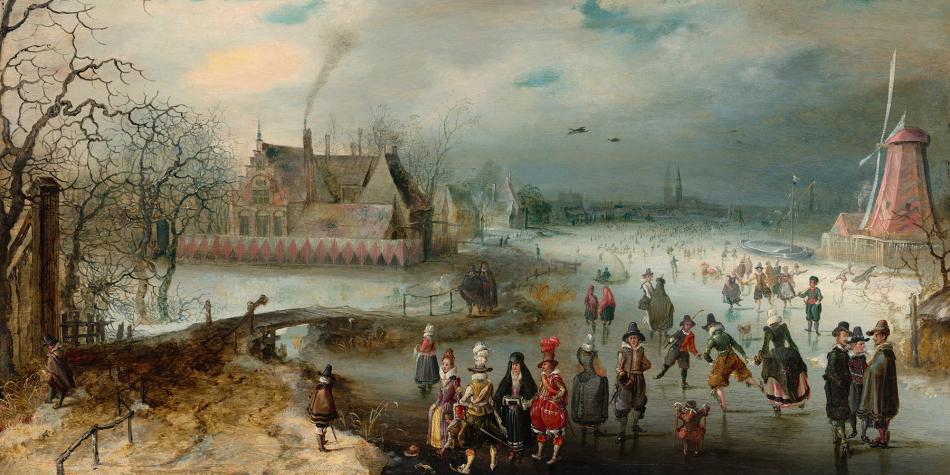Ice Scene near a Wooden Observation Tower
1646
Jan van Goyen
Artist, Dutch, 1596 - 1656

Jan van Goyen was one of the great proponents of the innovative “tonal” style of Dutch landscape painting that celebrated local scenes and subjects in hues of brown, gray, and ochre. The tonal landscapes of the 1630s and 1640s ushered in the golden age of Dutch landscape painting, and Van Goyen’s body of work spans the beginnings of this style through its transition into more colorful and atmospheric depictions.
Ice Scene near a Wooden Observation Tower illustrates an important transitional moment in Van Goyen’s career, as he moved away from the tonal style. Here he concentrates on weather and atmospheric effects, such as the swiftly moving clouds that convey the day’s cold breeze and the bright blue sky peeking from behind them.
This winter scene also provides a perfect opportunity for admiring Van Goyen’s technique as well as for enjoying the narrative presented. Couples skating, passengers riding a horse-drawn sled, and men setting out to ice fish indicate the range of activities enjoyed by the Dutch during the severe winters in Western Europe in the 17th century, an era known in climate history as “The Little Ice Age.” Van Goyen’s range of techniques mirrors the range of activities, from the thickly painted clouds to the quickly brushed-in outlines of figures and boats.

NGA, West Building, G-013-A
Artwork overview
-
Medium
oil on panel
-
Credit Line
-
Dimensions
overall: 36.5 × 34.3 cm (14 3/8 × 13 1/2 in.)
-
Accession Number
2014.35.1
More About this Artwork

Article: Painting Climate Change in the 17th Century
An environmental historian discusses how artists documented the Little Ice Age.
Artwork history & notes
Provenance
Jacques-Phillippe Le Bas [1707-1783], Paris; (his estate sale, at his residence, Paris, 1-6 December 1783, no. 1);[1] Dulac. (Eugene Slatter Gallery, London), in 1949.[2] (Thomas Agnew & Sons, Ltd., London);[3] purchased 1976 by private collection, United States; (sale, Sotheby's, London, 30 January 2014, no. 37); (Richard Green [Fine Paintings], London); sold 30 May 2014 to NGA.
[1] The painting sold for 340.3 livres; its description in the sale catalogue reads: "...ce Tableau d'une bonne couleur, est un des plus beaux de ce Maitre."
[2] The painting was included in the 1949 summer exhibition at the Slatter Gallery.
[3] On the reverse of the painting is an Agnew's label with number 39446 on it.
Associated Names
Exhibition History
1949
Exhibition of Dutch and Flemish Masters, Eugene Slatter Gallery, London, 1949, no. 4, repro., as Skating Scene.
2018
Water, Wind, and Waves: Marine Paintings from the Dutch Golden Age, National Gallery of Art, Washington, D.C., 2018, unnumbered brochure.
2021
Clouds, Ice, and Bounty: The Lee and Juliet Folger Fund Collection of Seventeenth-Century Dutch and Flemish Paintings, National Gallery of Art, Washington, 2021, no. 14, repro.
Bibliography
1972
Beck, Hans-Ulrich. Jan van Goyen 1596-1656, ein Oeuvreverzeichnis. 4 vols. Vol. 2: Katalog der Gemälde. Amsterdam, 1973: 16, no. 30, repro.
2014
Wheelock, Arthur K., Jr. "Gifts and Acquisitons: Jan van Goyen, Ice Scene Near a Wooden Observation Tower." National Gallery of Art Bulletin no. 51 (Fall 2014): 21-22, repro.
Inscriptions
lower right on the boat, VG in monogram: VG 1646
Wikidata ID
Q20177233



